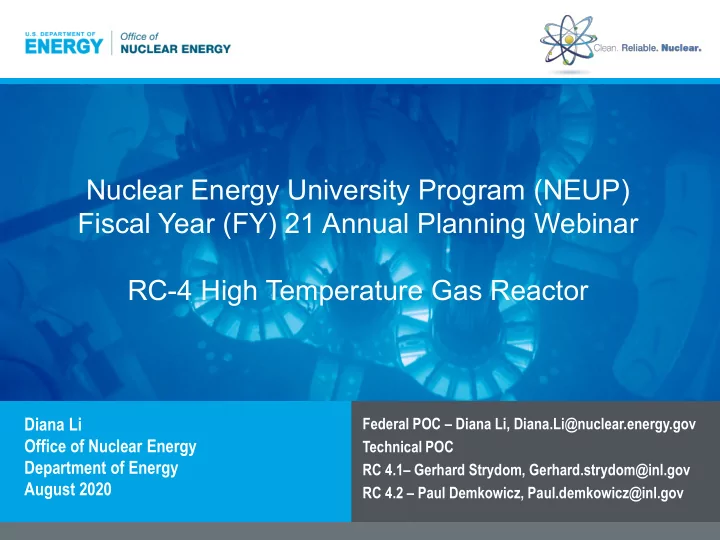

Nuclear Energy University Program (NEUP) Fiscal Year (FY) 21 Annual Planning Webinar RC-4 High Temperature Gas Reactor Diana Li Federal POC – Diana Li, Diana.Li@nuclear.energy.gov Office of Nuclear Energy Technical POC Department of Energy RC 4.1– Gerhard Strydom, Gerhard.strydom@inl.gov August 2020 RC 4.2 – Paul Demkowicz, Paul.demkowicz@inl.gov
Program Vision and Strategy Develop and qualify advanced reactor technologies necessary for the design and licensing of modular HTGRs, and reduce technical risks and barriers to commercial deployment High Temperature Alloy Fuel Fabrication, Characterization, Testing and Irradiation, and Codification Safety Testing Graphite Characterization, Design and Safety Methods Irradiation Testing, Modeling and Development and Validation Codification 2 energy.gov/ne
AGR TRISO Fuel Qualification 3 3 energy.gov/ne 3
Gas Reactor Technologies – Experimental Validation Scaled integral experiments to support design and licensing – Simulate coolant flow and heat transport in and from HTRs during accident scenarios – code validation to support licensing • Natural Convection Shutdown heat removal Test Facility (NSTF) at ANL for severe accident heat removal • High Temperature Test Facility (HTTF) at Oregon State University for core thermal hydraulics – heated prismatic block core simulator, ¼ scale 4 Natural convec ecti tion S Shutd tdown h heat t High Temper mperatu ture T Test F t Facility ty 4 remova val l Test F Facili lity ( (NSTF) for vessel (HTTF) F) at Oregon State University cooling studies 4 energy.gov/ne 4
Examples of HTGR Industry Developers 5 energy.gov/ne 5
RC-4.1: Heat Transfer Characterization in Horizontally Orientated Micro HTGRs under Pressurized Conduction Cooldown Conditions • Proposals are requested to assess the heat transfer for prototypical conditions in a micro HTGR – Cover low-velocity flow regime that will establish in a helium-filled prismatic core at approximately 3-5 MPa. – Establish representative power and heat profile at start of the PCC event, – Be capable of operating up to 1200oC for 48 hours – Spatial variance in the peak “fuel” temperatures as a function of time and heat transfer rates from the core to the vessel through a typical cavity region – Quantify the various contributions of radiation vs. convective heat transfer if possible – All measured data must be produced with estimates of uncertainties associated with data • PI’s encouraged to consult with US-based HTGR developers • Standard Fort St. Vrain/MHTGR-350 fuel block design and helium are preferred as the core geometry and working fluid 6 energy.gov/ne
RC-4.2: HIGH TEMPERATURE GAS REACTOR FISSION PRODUCT SOURCE TERM • Previously, reactor concept design information insufficient to determine the fission product behavior in the reactor coolant system • Phenomena such as fission product plateout, lift-off, washoff, and vaporization, as well as aerosol dynamics, are key in determining the behavior of circulating activity in a gas-cooled reactor coolant system and calculating total fission product release during reactor accidents • This call seeks proposals for small-scale experiments to assess radionuclide behavior in reactor coolant circuits. This can include experimental configurations that approximate reactor designs, accounting for coolant system components (e.g., loop, blower and fans, thermal gradients, etc.), – Use appropriate scaling factors. – Consider design-basis accident scenarios that can have significant impact on radionuclide transport – Use latest industry design information 7 energy.gov/ne
Requirements • All experiments must be performed to NQA-1 standards. • Data, experiments, and calculations shall be submitted to the Idaho National Laboratory’s NGNP Data Management and Analysis System (NDMAS). • Assistance shall be provided by Idaho National Laboratory for NDMAS use and ensuring NQA-1 standards are properly established. 8 energy.gov/ne
Questions 9 energy.gov/ne
Recommend
More recommend